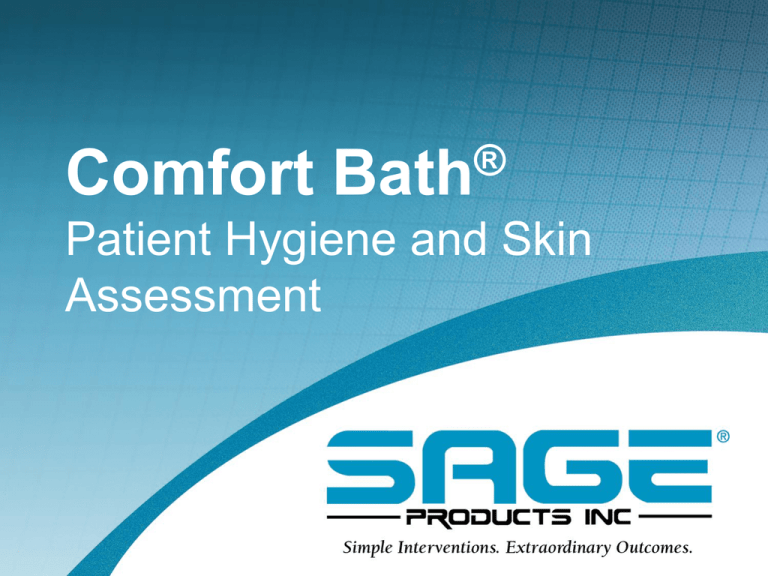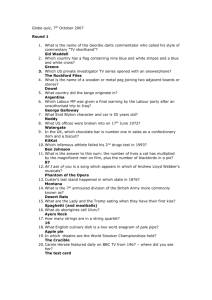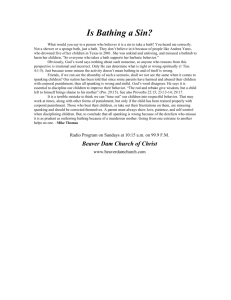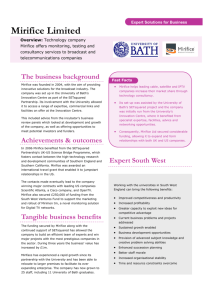in10464G - Sage Products Inc.
advertisement

Comfort ® Bath Patient Hygiene and Skin Assessment Who is Sage? Our goal is to promote a positive patient hygiene intervention between caregivers and patients to achieve improved clinical outcomes, and increase satisfaction. Basinless Bathing is Growing Used in over 1800 hospitals across the country: Patient Satisfaction…It’s a soft cloth & it’s warm Nursing Satisfaction…Saves time, giving time back Infection Control Aspects…Transient bacteria, cross contamination, hospital tap water as a source, the basin, CDC guidelines Skin Assessment…Bathing is the best time to assess the patient’s skin Economical …Competitive with a basin bath Employee and Patient Satisfaction Correlation between the satisfaction of the nurse and the satisfaction of their patient • • • Nurses expressed a clear and significant preference for the disposable bath.1 Only 4% of patients feel clean and comfortable with the current basin bath method for patient cleansing.2 Only 34% of nurses said they had enough RNs to provide quality care and still fewer than 33% had enough staff to get their work done.3 1.Larson et al, American Journal of Critical Care, Comparison of Traditional and Disposable Bed Baths in Critically Ill Patients, May 2004; Vol. 13, No. 3, pg. 235-2 2.Comfort Bath® Cleansing System from Sage Products vs. the Basin Bath: Patient Preference Study, Barbara Skiba, RN, BSN 3. JCAHO, Health Care at the Crossroads: Strategies for addressing the evolving nursing crisis Hospital Washcloth Basin Vs. Disposable Washcloth Sage Patients’ Bath Basins As Potential Sources of Infection: A Multicenter Sampling Study Authors: Debra Johnson, RN, BSN, OCN, CIC; Lauri Lineweaver, RN BSN, CCRN; and Lenora M. Maze, RN, MSN, CNRN Publication: AJCC January 2009, Volume 18, No. 1 Objective: To identify and quantify bacteria in patients’ bath basins and evaluate the basins as a possible reservoir for bacterial colonization and a risk factor for subsequent hospitalacquired infection Background: Basins tested at 3 acute care hospitals • Presbyterian Hospital New Mexico (453 beds) • Wishard Health Services Indiana (319 beds) • Westerly Hospital Rhode Island (125 beds) • 92 basins from 3 ICU’s and a rehabilitation unit evaluated Patients’ Bath Basins As Potential Sources of Infection: A Multicenter Sampling Study Results • Bacteria grew in 98% of the samples!! • Organisms with highest rates of growth: – – – – – Enterococci (54%) Gram-negative organisms (32%) Staphylococcus aureus (23%) VRE (13%) MRSA (8%) • VRE and MRSA were cultured from bath basins of patients who were not carriers The Role of Interventional Patient Hygiene in Improving Clinical and Economic Outcomes Devin Carr, MSN, RN, ACNS-BC, CCRN, RRT and Richard Benoit, MSN, RN, CCRN Advances in Skin and Wound Care. Vol. 22 NO.2 February 2009 Objective Asses the efficacy of an evidence-based IPH protocol initiated at a university hospital aimed at reducing the incidence of PrU’s and impaired skin integrity Methods • • • • • 21-bed surgical intensive care unit at the Vanderbilt University Medical Center. 4 month study 2 Components: Staff education which sought to improve the knowledge base of the non-licensed staff, and patient intervention component which would improve communication of risk factors of PrUs to the registered nurses A pre and post intervention knowledge survey (clinical assessment forms) was conducted to determine the success of the education Implemented Comfort Bath with Skin Check and Shield Barrier cloths with Peri Check Educated around the Skin Check label and proper usage. Non-licensed staff received instruction in observational skills and the facilities bathing and incontinence management protocol The Role of Interventional Patient Hygiene in Improving Clinical and Economic Outcomes Devin Carr, MSN, RN, ACNS-BC, CCRN, RRT and Richard Benoit, MSN, RN, CCRN Advances in Skin and Wound Care. Vol. 22 NO.2 February 2009 Outcome • Pressure ulcers decreased from 7.14% to 0% • 100% of the staff were able to demonstrate adequate knowledge of hospital protocol and procedure after the intervention • Department manager confirmed by random sampling of the audit tools that reported alterations in skin integrity was followed up by the responsible RN The Science of Comfort Bath • High colony count found in bath water is similar to the number of bacteria found in urine from patients with UTIs1 • Bath water could serve as a high magnitude microbial reservoir of potentially antibiotic resistant organisms.1 • The patient’s skin may harbor more gram negative organisms once the basin bath is completed.2 1. Shannon et al, Journal of HealthCare Safety, Compliance & Infection Control, April 1999; Vol. 3, No. 4, pg. 180-184. 2. Susan M. Skewes, RN, ONC, RN Magazine. January 1994: 34-35. The Science of Comfort Bath Ruth Bryant article from Ostomy/Wound Management, 2001 • Strong correlation between bathing and skin integrity (the body’s first line of defense) • Current basin bath procedure can be cumulatively detrimental to skin condition and cause skin dryness and skin tears • Bathing is the best time to inspect the skin • Traditional bathing technique should be re-examined The Science of Comfort Bath Elaine Larsen study from American Journal of Critical Care, 2004 Nursing survey comparing traditional bathing to disposable bath determined disposable bath: • Is more convenient and easier to use • Cleans and moisturizes skin more effectively • Is more comfortable for patient • Requires fewer supplies • Is less expensive The Science of Comfort Bath Angela Clark article from Clinical Nurse Specialists, 2006 Looked at nosocomial infections and bath water: • Hospital tap water most overlooked and controllable source for nosocomial pathogens • Transmission from drinking, bathing and items rinsed with tap water causing a contaminated environment • Immunocompromised patients at highest risk • Recommendation is to keep immunocompromised patient away from hospital tap water Contains strong supporting references (e.g., NJOM) Functions of Patient Bathing 1. Health/Clinical • • • Cleanse and moisturize the skin Reduce gross bacterial count Complete full skin assessment / monitoring 2. Social • • Control patient odor Provide patient well-being 3. Comfort • Provide sensory stimulation Ruth Bryant, RN, MS, CWOCN; Bonnie Rolstad, RN, BA, CWOCN, Ostomy Wound Management 2001: 47(6), 18-27. Is the Basin a Source of HAIs? Persistence of Clinically Relevant Bacteria on Dry Inanimate Surfaces Type of bacterium Duration of persistence (range) Acinetobacter spp. 3 days to 5 months Escherichia coli 1.5 hours – 16 months Enterococcus spp. Inc. VRE and VSE 5 days – 4 months Klebsiella spp. 2 hours to > 30 months Pseudomonas aeruginosa 6 hours – 16 mths; on dry floor: 5 wks Salmonella spp. 1 day Serratia marcescens 3 days – 2 mths; on dry floor: 5 wks Staphylococcus aureus, inc. MRSA 7 days – 7 months BMC Infect Dis. 2006; 6: 130. Published online 2006 August 16. doi: 10.1186/1471-2334-6-130. O’Flynn, APIC, 06/07 Methods • 25 dry patient bath basins were cultured – 10 CCU & 15 Med Surg – Basins were in rooms > 48 hours – Used at least once • ICP swabbed each basin with 2 swabs • Samples were streaked on a 5% blood agar Petri dish O’Flynn – Tables and Graphs McGuckin, APWCA, 4/07 • • • • • 18-month study, 14-bed ICU 23 additional UTI’s and $107K in cost Both Larson and Vernon found . . . Shannon = bath water - bacteria - UTIs Clark = keep tap water away from . . . Clearly, the basin should be considered as a major source of HAIs Unmet Clinical Bathing Need? Skin issues often go undetected 1 Proof – P.U’s cost U.S. healthcare system $1.3 billion/year 2 – Skin breakdown: Top healthcare litigation – P.U.’s cost average hospital $400,000 to $700,000/year 1 – Most stage I and stage II go unreported 1 – Nearly half of all P.U.’s develop in hospital 2 Result of Not Implementing a Skin Monitoring System – Costs go up, patient and RN satisfaction go down, increased risk for infection Solution – Bathing is the best time to assess the skin 1. Robinson C, et al., “Determining the efficacy of a pressure ulcer prevention program by collecting prevalence and incidence data: A unit-based effort, “ Ost/Wound Mgmt. 2003: 49 (5): 44-51. 2. Amulung Sr, Miller WL, Bosley LM, “The 1999 National Pressure Ulcer Prevalene Survey: A Benchmarking Approach,” Who’s providing the care? Creating a Safety Net for Patients • Employ consistently clean or sterile products and processes • Making good use of everyday supply items • Utilize ALL team members • Train caregivers to make frequent observations New Sage Bathing Product Objective • Deliver warm, soothing cleansing and moisturizing quickly to the patient • Remove odor and bacteria; stimulate tissue • Complete a daily skin inspection or assessment from head-to-toe Why now? New CMS Guidelines • Hospitals will no longer receive higher payments for the additional costs associated with treating patients for certain HAIs and medical errors. – UTIs – Pressure ulcers • What role does bathing have on these outcomes? Market Review - Bath Bath Sales* $37 M Current Market Capture: 19.2% Potential Bath Market $192.7 M Market Available: 80.8% *Source: Inpatient admissions and LOS for US and Canada per 2006 HCUP Nationwide Inpatient Sample (NIS) and 2006 Canadian Institute for Health Information (CIHI). Rates calculated on assumption of LOS shortened by first day (3.77 down from 4.77). Average bath package pricing of $1.21 per package, one package per bath. Bath Sales figures: Sage Sales from September 2007 – August 2008 BASINLESS BATHING WASH KITS: SKIN CARE 80% 70% Annual 2011 Market 60% 50% 40% 30% 20% 10% 0% 76.3% 18.8% * others include: Bard Medical/Incline Technologies, No-Rinse, Donovan Industries 2.5% 1.8% .5% <0.1% each nd Source: GHX Trend Report (Dollars) 2 Quarter, 2011 Hospital; Annual market represents last 4 quarters of data 2005 WOCN Survey Results 297 Surveys Received 3. At my facility, there is a need to improve (check all that apply): number of responses 200 160 155 138 100 120 90 80 40 0 46% Frequency and/or consistency of skin assessment/ monitoring 34% Method of skin assessment/ monitoring 52% Communication of skin problems between different levels of caregivers 30% No response 7/26/05 2005 WOCN Survey Results 297 Surveys Received 4. At my facility, patients at risk for skin breakdown receive a full skin assessment (approximately): 142 number of responses 160 120 71 80 34 36 40 0 48% Daily 6 2% Every other day 8 3% Every third day 11% 12% Weekly Not sure 24% No response 7/26/05 IHI’s 5-Million Lives Getting Started Kit: Prevent Pressure Ulcers How-to-Guide Six Essential Elements of Pressure Ulcer Prevention 1. Conduct a Pressure Ulcer Admission Assessment for All Patients 2. Reassess Risk for All Patients Daily 3. Inspect Skin Daily 4. Manage Moisture: Keep the Patient Dry and Moisturize Skin 5. Optimize Nutrition and Hydration 6. Minimize Pressure http://www.ihi.org/ihi How-to Guide Six Essential Elements of Pressure Ulcer Prevention Inspect Skin Daily Skin integrity may deteriorate in a matter of hours in hospitalized patients. Because risk factors change rapidly in acutely ill patients, daily skin inspection is crucial. Patients identified as being at risk need a daily inspection of all skin surfaces, “from head to toe.” Special attention should be given to areas at high risk for pressure ulcer development such as the sacrum, back, buttocks, heels, and elbows. Ideally, staff should incorporate a skin inspection into their work, every time they assess the patient. How-to Guide Six Essential Elements of Pressure Ulcer Prevention What processes can be put in place to ensure daily inspection of the skin? • Adapt documentation tools to prompt daily skin inspection, documentation of findings, and initiation of prevention strategies as needed. • Educate all levels of staff to inspect the skin any time they are assisting the patient, for example, when assisting patient to the chair, moving from one area to the other, and while bathing. Upon recognition of any change in skin integrity, notify staff so that appropriate interventions can be put in place. The Case for Skin Monitoring • JCAHO 2007 National Patient Safety Goals – Goal: Improve the effectiveness of communication among caregivers. • Measure, assess and, if appropriate, take action to improve the timeliness of reporting • AHRQ Guidelines – Regular skin assessment for early signs of pressure injury. – Keep in mind that those who are at significant risk may develop Stage I ulcers in less than 2 hours on a standard support surface. • Mandatory reporting • And now, IHI 5-Million Lives Campaign Folk Dahl BA, Frantz R, “Prevention of pressure ulcers,” Iowa City (IA): Univ of Iowa Gerontological Nursing Interventions Research Center, research Dissemination Care: 2002 May. The Science of Comfort Bath Bellin Hospital – IHI Poster, 2006 • Wanted to improve skin inspection and rapid response to skin injury to decrease nosocomial PUs • Clinicians conducted pre- and post-intervention criteria (evaluation forms) • Established bathing protocol with Skin Check • Resulted in improved patient outcomes: – PUs decreased from 18% to 5.88% – There is a need for rapid and frequent inspection of skin integrity – Bathing with a monitoring tool facilitates this activity How Skin Check™ Works • Peel the skin monitoring label off and set aside • Bathe patient as normal – assistant looks for skin integrity issues • If an issue is observed, mark label • Communicate to RN responsible for that patient Skin Check™ Program Early Detection Means Early Protection 1. Skin Protection – Fortifying the skin • Right solution – pH balanced • Lotion and moisturizers to nourish the skin • Soft cloth for gentle yet thorough cleaning – More hygienic way to provide a bath – fewer opportunities for recontamination of the skin1 2. Early Detection – Observation of skin issues – Communication of red skin issues – Action Larson EL, et al., : “Comparison of traditional and disposable bed baths in critically ill patients”, American Journal Critical Care. 2004; 13(3): 235-241. Bathing and Clinical Outcomes Costs Nursing Satisfaction Infection Skin Monitoring Skin Care Time/Quality Patient Satisfaction Comprehensive Bathing Program Includes . . . 1. Protocol 2. Observation program – Assessment / Monitoring 3. Incorporate a bathing system that best meets the hospital’s clinical and economic needs Sage – The Only Company With: • Clinical proof • Skin assessment / monitoring tools • Customized training and In-service programs • Product options – – – Three cloth thicknesses Deodorant Three, five, and eight packs • Fully insulated packaging • Hospital grade warmers and microwaves Sage is Fully Committed to: • Achieving improved outcomes – Implementation and compliance to PIP’s and protocols • Product innovation – Skin Check, Exopheryl, Insulation, Tencel, etc. • Helping you manage usage Thank You For Your Time




